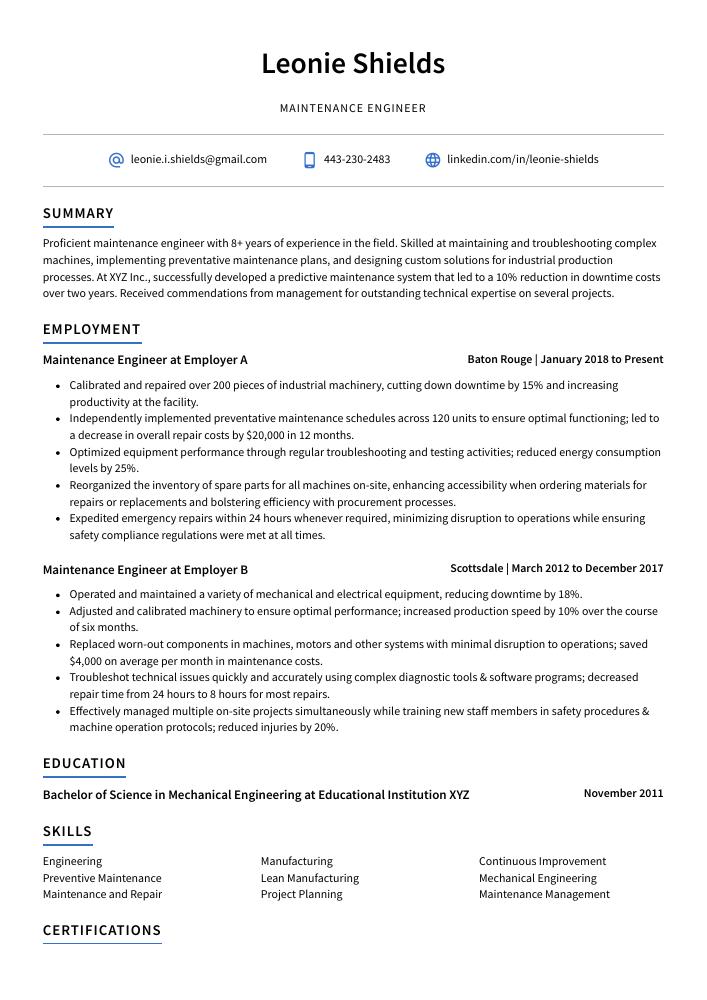Maintenance Engineer Resume Guide
Maintenance Engineers are responsible for ensuring that all machinery and equipment runs smoothly. They inspect, diagnose, maintain and repair mechanical systems to keep them functioning properly. Additionally, they use diagnostic tools to analyze problems with machines and develop strategies for repairing or replacing components as needed.
You have the knowledge and experience to keep any facility running smoothly, but employers don’t know who you are. You need a resume that emphasizes your expertise in maintenance engineering so they can take notice of your skillset.
This guide will walk you through the entire process of creating a top-notch resume. We first show you a complete example and then break down what each resume section should look like.
Table of Contents
The guide is divided into sections for your convenience. You can read it from beginning to end or use the table of contents below to jump to a specific part.
Maintenance Engineer Resume Sample
Leonie Shields
Maintenance Engineer
[email protected]
443-230-2483
linkedin.com/in/leonie-shields
Summary
Proficient maintenance engineer with 8+ years of experience in the field. Skilled at maintaining and troubleshooting complex machines, implementing preventative maintenance plans, and designing custom solutions for industrial production processes. At XYZ Inc., successfully developed a predictive maintenance system that led to a 10% reduction in downtime costs over two years. Received commendations from management for outstanding technical expertise on several projects.
Experience
Maintenance Engineer, Employer A
Baton Rouge, Jan 2018 – Present
- Calibrated and repaired over 200 pieces of industrial machinery, cutting down downtime by 15% and increasing productivity at the facility.
- Independently implemented preventative maintenance schedules across 120 units to ensure optimal functioning; led to a decrease in overall repair costs by $20,000 in 12 months.
- Optimized equipment performance through regular troubleshooting and testing activities; reduced energy consumption levels by 25%.
- Reorganized the inventory of spare parts for all machines on-site, enhancing accessibility when ordering materials for repairs or replacements and bolstering efficiency with procurement processes.
- Expedited emergency repairs within 24 hours whenever required, minimizing disruption to operations while ensuring safety compliance regulations were met at all times.
Maintenance Engineer, Employer B
Scottsdale, Mar 2012 – Dec 2017
- Operated and maintained a variety of mechanical and electrical equipment, reducing downtime by 18%.
- Adjusted and calibrated machinery to ensure optimal performance; increased production speed by 10% over the course of six months.
- Replaced worn-out components in machines, motors and other systems with minimal disruption to operations; saved $4,000 on average per month in maintenance costs.
- Troubleshot technical issues quickly and accurately using complex diagnostic tools & software programs; decreased repair time from 24 hours to 8 hours for most repairs.
- Effectively managed multiple on-site projects simultaneously while training new staff members in safety procedures & machine operation protocols; reduced injuries by 20%.
Skills
- Engineering
- Manufacturing
- Continuous Improvement
- Preventive Maintenance
- Lean Manufacturing
- Mechanical Engineering
- Maintenance and Repair
- Project Planning
- Maintenance Management
Education
Bachelor of Science in Mechanical Engineering
Educational Institution XYZ
Nov 2011
Certifications
Certified Maintenance and Reliability Professional (CMRP)
Soc
May 2017
1. Summary / Objective
Your resume summary or objective should be a concise and compelling introduction to who you are as an engineer. In this section, you can highlight your experience in maintenance engineering, such as the number of years’ experience you have or any certifications that demonstrate your expertise. You could also mention how many successful projects you’ve completed and what kind of equipment/machinery is familiar to you.
Below are some resume summary examples:
Seasoned maintenance engineer with 8+ years of experience and a track record of successfully completing projects within budget. Highly experienced in all aspects of maintenance engineering, including preventive, predictive and corrective methodologies. Skilled at troubleshooting and problem-solving for mechanical systems such as pumps, motors, valves etc. Dedicated to providing superior customer service while ensuring optimal performance from equipment onsite.
Well-rounded maintenance engineer with 6+ years of experience in maintenance and repair operations. Experienced in both preventive and corrective maintenance, as well as the installation of equipment for production lines and facilities. Skilled at troubleshooting complex issues while maintaining cost-efficiency; managed 35 projects related to facility repairs with a 100% success rate. Received an award from ABC Company for reducing downtime by 20%.
Talented maintenance engineer with 9+ years of experience in a variety of industrial settings. Skilled in providing full-service preventative and corrective maintenance, driving down downtime while improving machine performance. Proven track record of successfully troubleshooting advanced mechanical issues and ensuring equipment is running at peak efficiency. Looking to bring expertise to ABC Manufacturing’s team as the next Maintenance Engineer.
Accomplished maintenance engineer with 8+ years of expertise in maintaining and troubleshooting electrical, mechanical, hydraulic, and other systems. Skilled at identifying problems quickly to minimize downtime while working within a budget. Successfully managed the installation of new equipment for ABC Company that improved production efficiency by 25%. Seeking to leverage experience as Maintenance Engineer at XYZ Corporation.
Professional maintenance engineer with 8+ years of experience in the management and maintenance of machinery, equipment, and systems. Proven ability to identify root cause issues quickly for cost-effective repairs. Skilled in developing preventive maintenance plans that reduce downtime by up to 60%. Seeking a position at ABC where I can apply my technical knowledge towards ensuring safe operations and improving efficiency.
Determined and reliable maintenance engineer with 5+ years of experience in the manufacturing and engineering industries. Experienced in overseeing, repairing, and updating equipment to ensure proper operation. Passionate about providing quality customer service while optimizing operations for maximum efficiency. Seeking a position at ABC where I can use my expertise to help reduce costs and improve safety standards.
Passionate maintenance engineer with 10+ years of experience in the field. Experienced in performing preventative maintenance, troubleshooting machinery, and making repairs for a wide variety of industrial equipment. Skilled at reading blueprints and schematics to determine appropriate repair strategies. Worked on-site or remotely to address customer requirements and resolve complex issues quickly and efficiently.
Dependable maintenance engineer with 5+ years of experience in troubleshooting and repairing equipment. At XYZ, conducted 500 repairs on facility machinery to improve production efficiency by 30%. Expertise includes preventive maintenance, inventory management, quality control checks, and repair methods. Certified HVAC/R Technician with a knack for problem-solving complex technical issues.
2. Experience / Employment
For the experience section, list your employment history in reverse chronological order, meaning the most recent job is listed first.
When writing out what you did in each role, use bullet points to make it easier for the reader to digest. You should also provide detail and explain any quantifiable results you achieved while on the job.
For example, instead of saying “Maintained equipment,” you could say, “Performed regular maintenance checks on a variety of industrial machinery which resulted in an average downtime reduction of 20%.”
To write effective bullet points, begin with a strong verb or adverb. Industry specific verbs to use are:
- Installed
- Inspected
- Troubleshot
- Repaired
- Adjusted
- Replaced
- Calibrated
- Monitored
- Operated
- Assembled
- Tested
- Diagnosed
- Serviced
- Upgraded
- Programmed
Other general verbs you can use are:
- Achieved
- Advised
- Assessed
- Compiled
- Coordinated
- Demonstrated
- Developed
- Expedited
- Facilitated
- Formulated
- Improved
- Introduced
- Mentored
- Optimized
- Participated
- Prepared
- Presented
- Reduced
- Reorganized
- Represented
- Revised
- Spearheaded
- Streamlined
- Structured
- Utilized
Below are some example bullet points:
- Monitored and maintained the overall performance of machinery and equipment, ensuring that all systems were running efficiently; decreased downtime by 25% over an 8-month period.
- Utilized a variety of tools to diagnose problems, repair damages, install components and carry out preventive maintenance activities on power plants, pumps and motors.
- Participated in weekly inspection rounds to check for potential hazards or malfunctions in complex industrial machines; identified faulty parts with 90% accuracy rate within 30 minutes averagely per round.
- Meticulously followed blueprints, diagrams and technical manuals when performing repairs & troubleshooting tasks; reduced customer complaints by 20%.
- Prepared detailed reports on inspections findings as well as daily work records including labor hours spent on each task; improved job tracking system efficiency by 10%.
- Programmed and operated computer-controlled machines and testing equipment to diagnose, maintain and repair electrical, mechanical, hydraulic and pneumatic systems; reduced downtime by 15% over the course of 3 months.
- Tested production machinery on a daily basis for potential malfunctions or defects; identified 10+ issues before they became major problems that could have resulted in costly repairs & replacement parts.
- Successfully conducted preventive maintenance checks & risk assessments on all factory machines according to set safety protocols, significantly reducing accidents caused by operational failure by 25%.
- Facilitated troubleshooting activities when necessary to identify root cause of machine breakdowns quickly; drastically decreased average resolution time from 8 hours/issue to 4 hours/issue within 6 months’ period.
- Upgraded existing automated systems with modern components while ensuring compatibility with existing hardware & software architecture; improved system performance efficiency rate by 22%.
- Introduced a new preventive maintenance program across a team of 10 engineers, resulting in an increase of equipment reliability by 25%.
- Serviced and maintained all factory machinery to ensure they were running at their peak performance; improved output efficiency by 10% on average.
- Structured comprehensive overhauls for complex machinery according to engineering specifications and industry standards; ensured safety compliance in the workplace with zero accidents reported since implementation.
- Demonstrated excellent troubleshooting skills while diagnosing issues with malfunctioning machines, leading to successful repairs within hours instead of days or weeks as originally expected from other contractors previously hired for similar projects before.
- Confidently handled emergency repair situations using advanced tools such as welding torches and electrical meters under strict deadlines without compromising quality assurance standards set forth by top management personnel.
- Spearheaded the maintenance of over 100 pieces of facility equipment, including HVAC systems, boilers and electrical wiring; reduced overall repair costs by 10%.
- Mentored junior engineers in the proper use of tools, techniques and safety protocols to develop their skillset in preventive maintenance; boosted efficiency levels across all projects by 15%.
- Competently identified mechanical issues with a variety of machines using advanced diagnostic software and troubleshooting methods; resolved an average of 5 technical problems per week ahead of schedule.
- Streamlined daily operations through implementation & enforcement of guidelines on safety procedures for both staffs & customers that were compliant with industry standards; improved overall customer satisfaction ratings by 20 points within 6 months.
- Represented the company at trade-shows & conventions to network with other professionals while offering advice on best practices related to property management solutions as partof our consultants team.
- Developed and implemented maintenance plans to ensure the smooth functioning of mechanical, electrical and plumbing systems in a 600-person office building; improved operational efficiency by 35%.
- Reduced downtime on all equipment by 20% through regular inspections and preventative maintenance, while also maintaining compliance with industry regulations and safety standards.
- Assessed repair needs for over 40 pieces of machinery daily, including motors, pumps, conveyor belts & HVAC units; completed repairs within approved budgets 98% of the time.
- Presented cost estimates for major repair projects to management team members each month; secured $75k budget approval from executive board last quarter for critical upgrades across facility departments.
- Actively participated in staff trainings focusing on safe use of tools/equipment as well as advanced problem-solving techniques such as root cause analysis (RCA).
- Advised 15+ engineers on best practices and methods for maintaining mechanical, hydraulic and pneumatic systems; improved uptime by 20% since taking over as lead maintenance engineer.
- Compiled an extensive handbook of detailed instructions to ensure proper installation of new equipment in accordance with industry safety regulations; reduced machine downtime due to improper installations by 45%.
- Installed 10+ pieces of heavy machinery onto the production line, streamlining workflow processes while adhering to all necessary health & safety protocols; decreased total production time per unit by 25%.
- Diligently inspected all machines used in the facility twice daily for any signs of wear or malfunctioning parts, resulting in a 15% reduction in unscheduled repairs over the past year.
- Improved overall efficiency levels throughout the manufacturing plant through regular preventive maintenance services such as oil changes, filter replacements and lubrication checks; saved $20K annually on repair costs alone.
- Assembled and installed over 350 pieces of equipment & machinery in the last 6 months, cutting down company maintenance costs by 15%.
- Substantially decreased downtime with preventative and corrective maintenance on production line machines; eliminated operational interruptions for a total of 70 hours within the quarter.
- Formulated cost-effective solutions to mechanical problems that minimized parts purchasing expenses and labor costs; saved up $10,000 in repair bills this year alone.
- Repaired broken tools and malfunctioning equipments promptly using advanced diagnostic methods; improved system performance by 20% overall since taking on role as Maintenance Engineer 3 years ago.
- Diagnosed electrical faults quickly and accurately while utilizing specialized testing instruments such as multimeters, oscilloscopes & clamp meters; reduced troubleshooting time per issue from 1 hour to 30 minutes or less on average.
- Revised maintenance and repair procedures for equipment and machinery, resulting in a 30% reduction of downtime across the entire facility.
- Coordinated with vendors to purchase essential parts/supplies; managed repairs on all HVAC systems, plumbing fixtures & electrical wiring to ensure proper functioning of building components at all times.
- Achieved energy efficiency savings worth $20,000 by identifying system malfunctions that caused optimal performance losses and addressing them accordingly.
- Reliably inspected production machines daily for any signs of wear or tear; identified potential problems early-on before they resulted in costly breakdowns or further damage due to negligence/overuse etc., thus saving company an estimated $25K annually in preventative maintenance costs alone!
- Developed detailed logbooks while performing regular inspections so as to track progress made over time regarding preventive maintenance schedules and quality assurance standards set forth by management team members.
3. Skills
Even though two organizations are hiring for the same role, the skillset they want an ideal candidate to possess could differ significantly. For instance, one may be on the lookout for an individual with experience in HVAC systems and the other may require expertise with electrical engineering.
As such, you want to tailor your skills section of your resume for each job that you are applying for. This is especially important because many employers use applicant tracking systems these days – they scan resumes looking for certain keywords before passing them on to a human recruiter or hiring manager.
Therefore, it’s essential to list relevant skills here as well as elaborate on the most significant ones in other sections like summary or work experience.
Below is a list of common skills & terms:
- 5S
- AutoCAD
- Automation
- Commissioning
- Continuous Improvement
- Electrical Engineering
- Electricians
- Electronics
- Engineering
- Factory
- HVAC
- Inspection
- Kaizen
- Lean Manufacturing
- MATLAB
- Maintenance
- Maintenance Management
- Maintenance and Repair
- Manufacturing
- Mechanical Engineering
- Operations Management
- PLC
- Plant Maintenance
- Pneumatics
- Preventive Maintenance
- Process Engineering
- Process Improvement
- Product Development
- Project Engineering
- Project Planning
- Root Cause Analysis
- SOLIDWORKS
- Six Sigma
- Team Leadership
- Teamwork
- Troubleshooting
4. Education
Including an education section on your resume will depend on how far along you are in your career. If you just graduated and have no work experience, mention your education below the resume objective. However, if you have plenty of work experience to showcase, it is not necessary to include an education section at all.
If an education section is included, try to focus on courses and subjects relevant to the maintenance engineer role that you are applying for.
Bachelor of Science in Mechanical Engineering
Educational Institution XYZ
Nov 2011
5. Certifications
Certifications are a great way to demonstrate your knowledge and expertise in a particular field. They show potential employers that you have taken the time and effort to gain an official recognition of your skills, which can be very attractive when it comes to hiring decisions.
Include any certifications relevant to the job you are applying for on your resume so that recruiters can quickly see what qualifications you possess. This will help them recognize how well-suited you are for the role and make their decision easier.
Certified Maintenance and Reliability Professional (CMRP)
Soc
May 2017
6. Contact Info
Your name should be the first thing a reader sees when viewing your resume, so ensure its positioning is prominent. Your phone number should be written in the most commonly used format in your country/city/state, and your email address should be professional.
You can also choose to include a link to your LinkedIn profile, personal website, or other online platforms relevant to your industry.
Finally, name your resume file appropriately to help hiring managers; for Leonie Shields, this would be Leonie-Shields-resume.pdf or Leonie-Shields-resume.docx.
7. Cover Letter
Attaching a cover letter to your job application is an important step in the process. It allows you to explain why you are a great fit for the position and provide more detail than what’s already stated on your resume.
Cover letters should be brief, usually no longer than 2 to 4 paragraphs, but they can make all the difference when it comes to getting hired or not. They give recruiters an insight into who you are as a person and how well-suited you would be for the role.
Below is an example cover letter:
Dear Candelario,
I am writing to apply for the Maintenance Engineer position at your company. With more than 10 years of experience in maintenance engineering and a strong background in mechanical and electrical systems, I am confident I can make a positive contribution to your team.
In my previous role as Maintenance Engineer at [company name], I was responsible for overseeing all aspects of facility maintenance, including HVAC, plumbing, electrical, and fire safety systems. I also managed a team of 12 maintenance technicians and developed preventive maintenance programs that increased equipment uptime by 15%. In addition, I led the implementation of a new work order management system that improved communication between departments and resulted in a 30% decrease in response time to repair requests.
My experience has given me the ability to troubleshoot complex problems quickly and effectively. In one instance, when our building experienced an issue with the water pressure in our sprinkler system, I was able to identify the root cause (a clogged filter) within minutes and implement a fix that prevented further issues from occurring. My colleagues have also commended me for my excellent problem-solving skills on several occasions.
I am knowledgeable about OSHA regulations related to facility safety and have successfully implemented policies and procedures that ensure compliance with these regulations. My commitment to safety is evident in my successful track record; during my tenure at [company name], we did not experience any workplace injuries or accidents requiring OSHA reporting.
I believe my skills and experience would be an asset to your organization. Please find attached a copy of my resume for your review; if you have any questions or would like additional information about my qualifications, please do not hesitate to contact me at [phone number] or [email address]. Thank you for your consideration—I look forward to hearing from you soon!
Sincerely,
Leonie
Maintenance Engineer Resume Templates
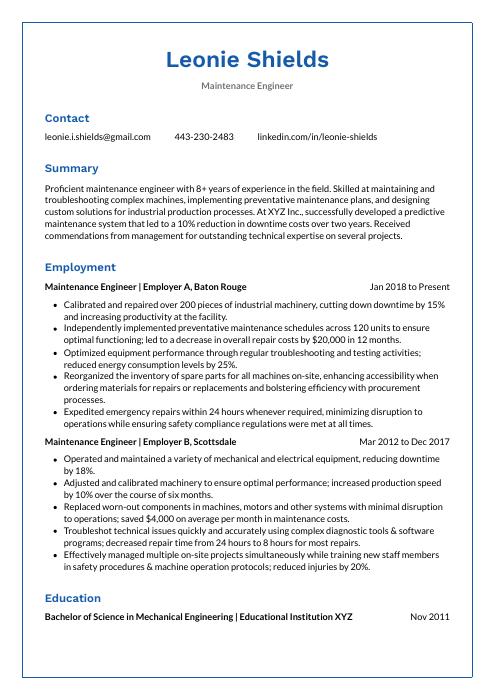 Markhor
Markhor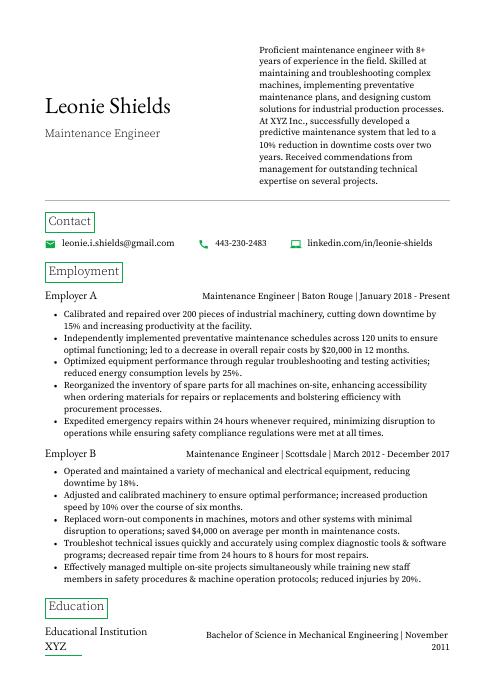 Quokka
Quokka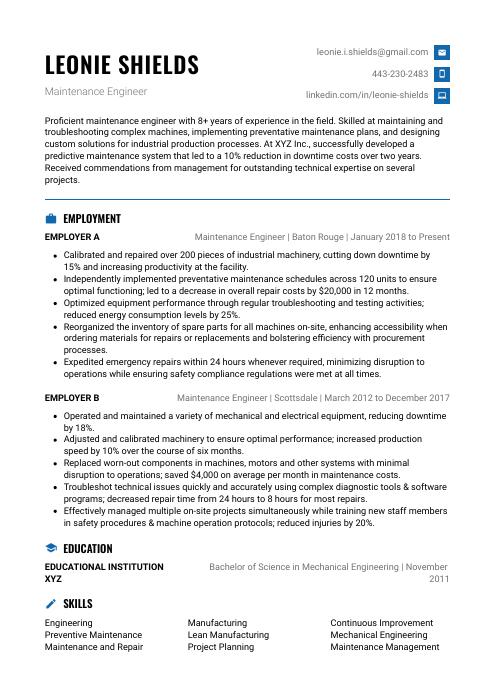 Echidna
Echidna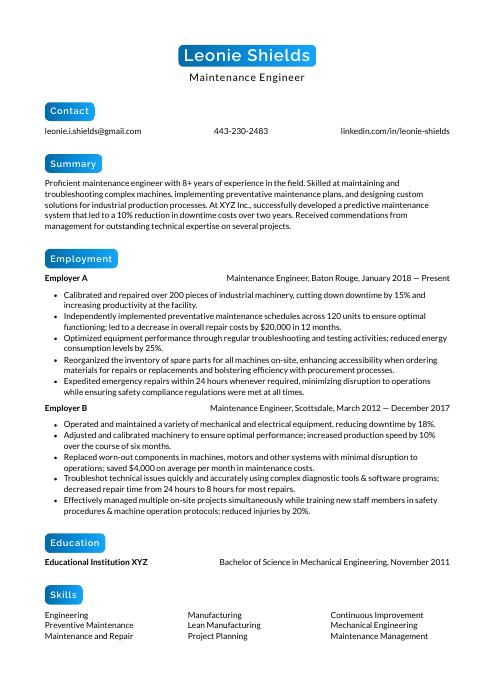 Kinkajou
Kinkajou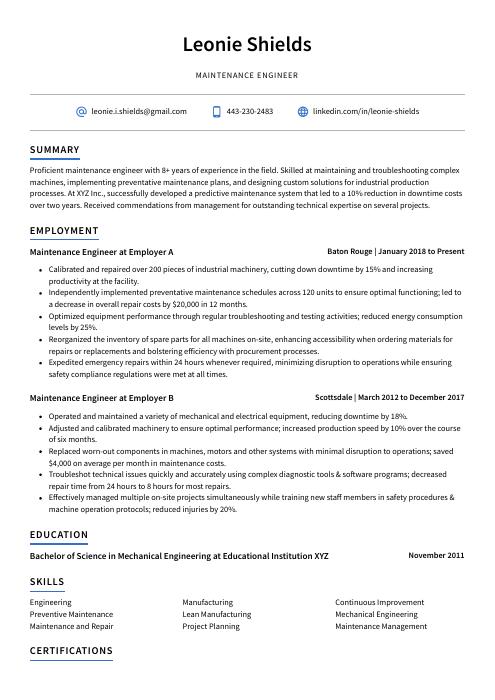 Axolotl
Axolotl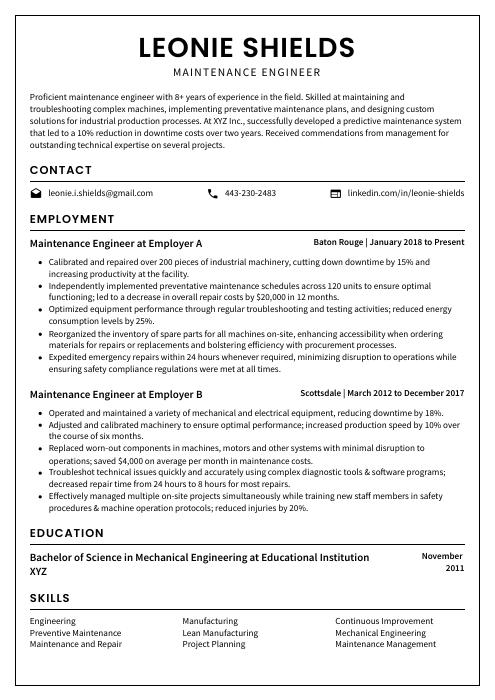 Cormorant
Cormorant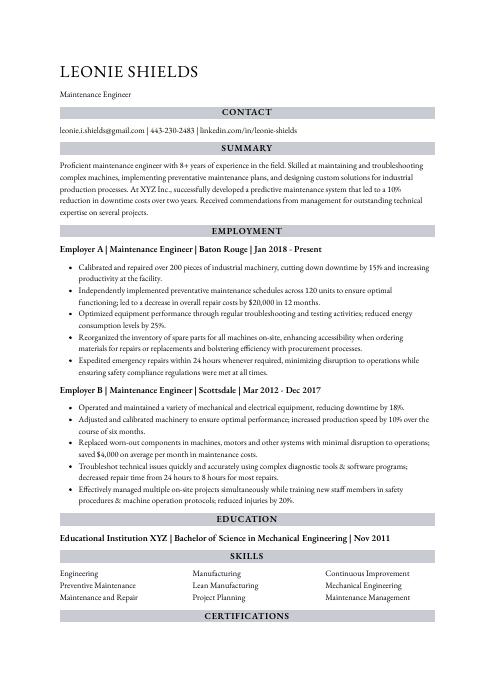 Numbat
Numbat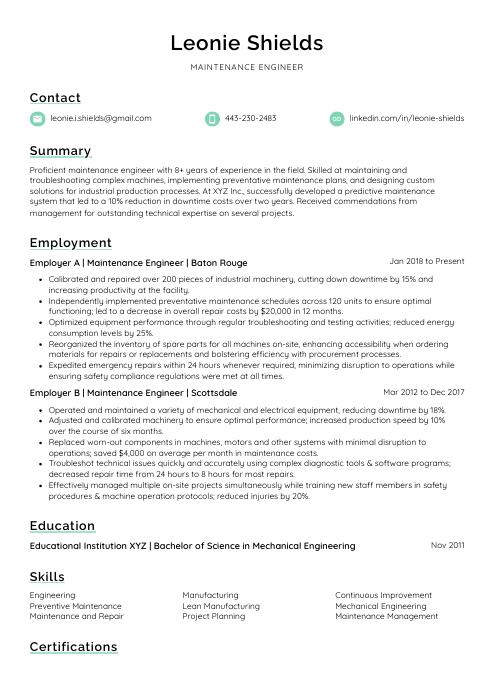 Lorikeet
Lorikeet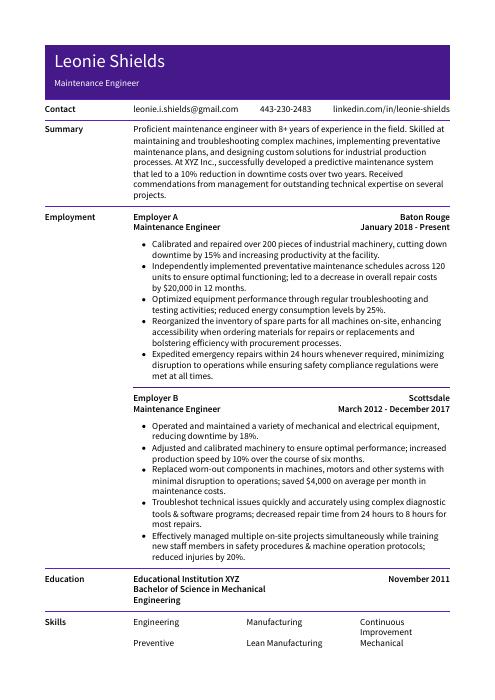 Pika
Pika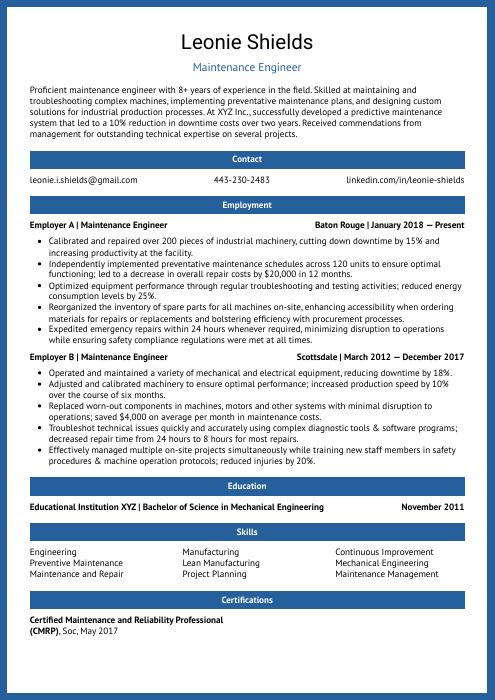 Ocelot
Ocelot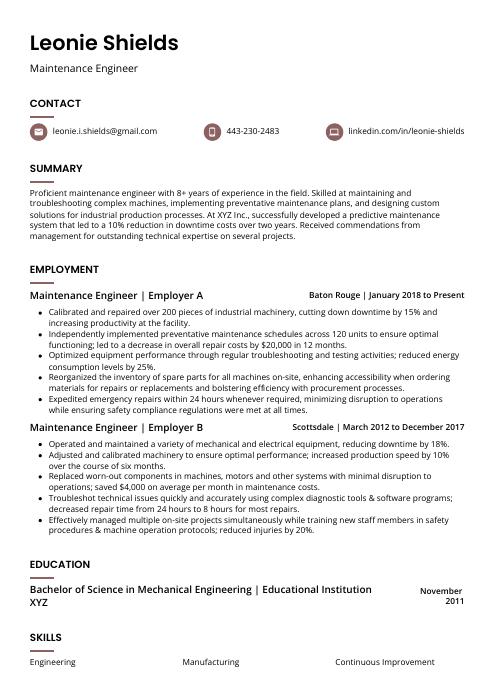 Fossa
Fossa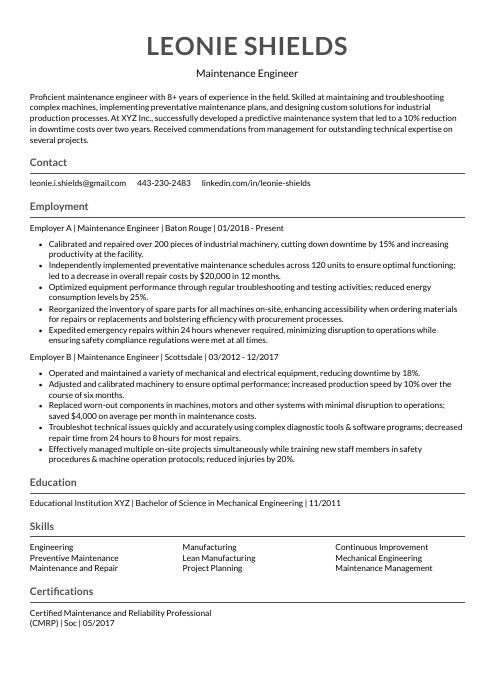 Indri
Indri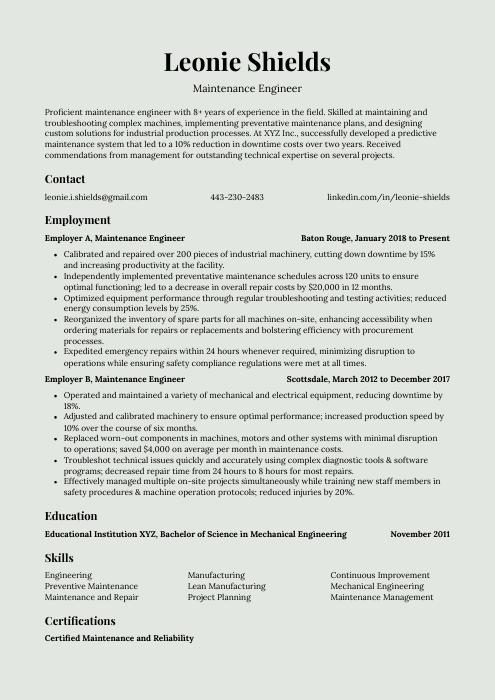 Saola
Saola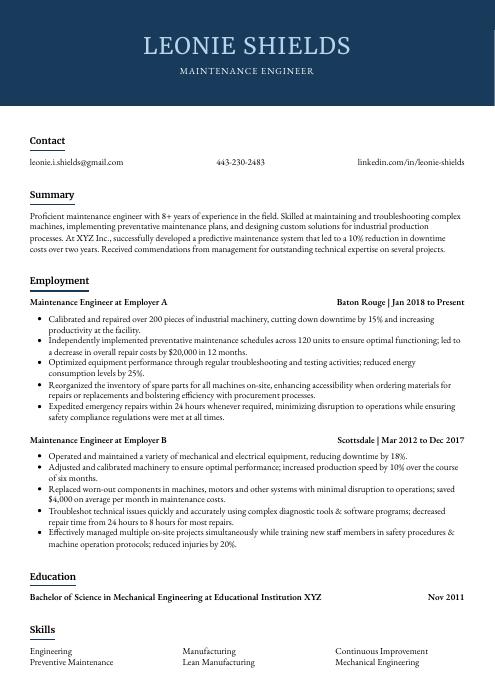 Bonobo
Bonobo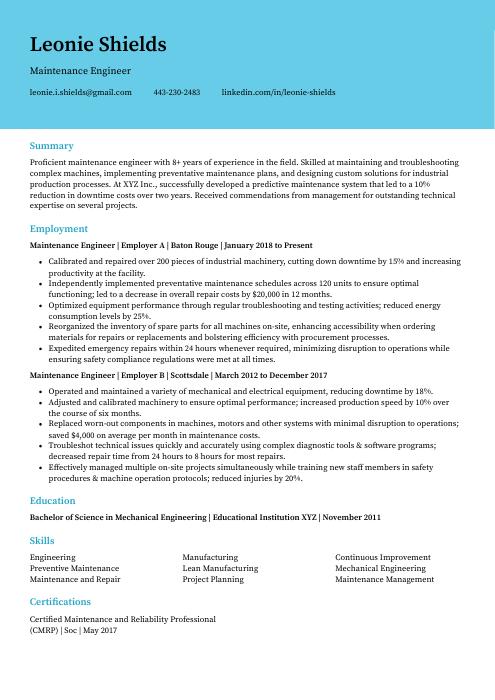 Dugong
Dugong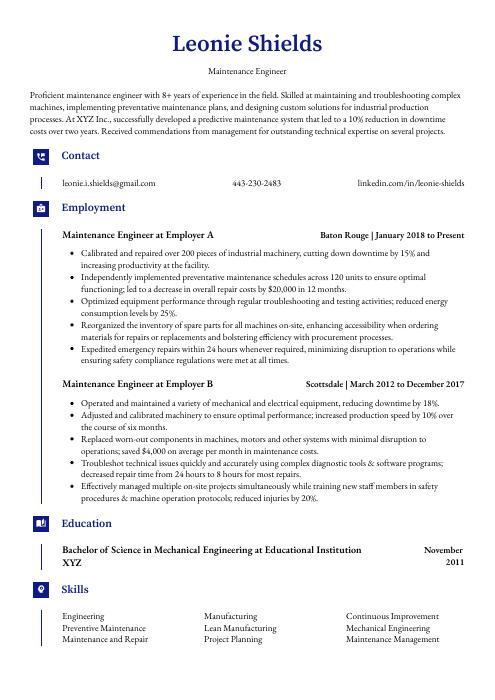 Gharial
Gharial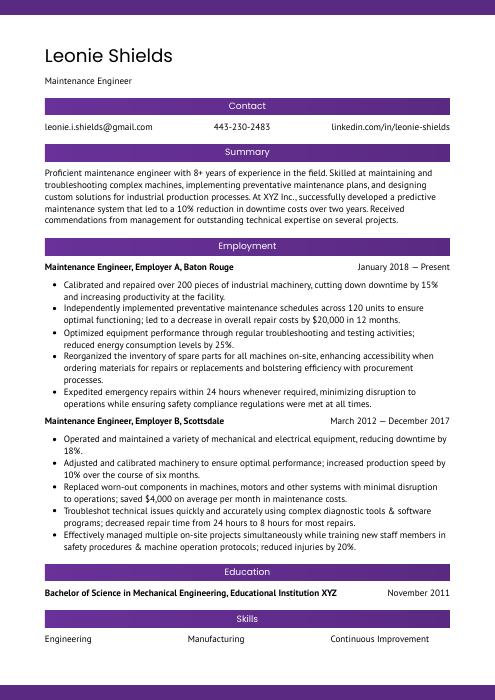 Jerboa
Jerboa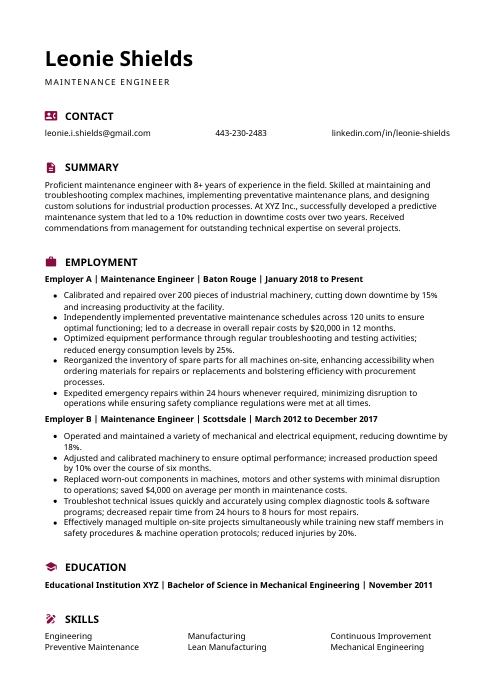 Hoopoe
Hoopoe Rezjumei
Rezjumei
